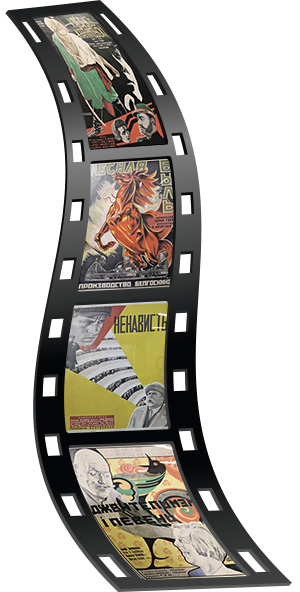In the Soviet times, Belgoskino was not afraid to experiment
Anyone who does not view cinema posters as an art form should visit the ‘Belarusian Cinematography of the 1920-30s’ exhibition, hosted by the Belarusian Embassy’s Business and Cultural Complex in Moscow. They will soon be persuaded of the cultural and artistic value in the many examples on display.
T
 he show brings together many masterpieces; European collectors are keen to pay good sums of money to buy them, as Igor Avdeev — the Director of the Belarusian Cinema History Museum — comments. “We were offered several hundred thousand dollars for this work,” he says, showing a poster of the film Hatred. “It was directed by Yuri Tarich — a founder of Belarusian cinematography whose biography details an adventurous and dramatic life. The director was born in 1885 in Polish Plock, to the family of a Tsar Army colonel. He attended a Russian gymnasium in Poland and later took part in the Russo-Japanese War and WW1. In the break between wars, Yuri was exiled to the Tobolsk Province for voicing his free thinking ideas too openly.”
he show brings together many masterpieces; European collectors are keen to pay good sums of money to buy them, as Igor Avdeev — the Director of the Belarusian Cinema History Museum — comments. “We were offered several hundred thousand dollars for this work,” he says, showing a poster of the film Hatred. “It was directed by Yuri Tarich — a founder of Belarusian cinematography whose biography details an adventurous and dramatic life. The director was born in 1885 in Polish Plock, to the family of a Tsar Army colonel. He attended a Russian gymnasium in Poland and later took part in the Russo-Japanese War and WW1. In the break between wars, Yuri was exiled to the Tobolsk Province for voicing his free thinking ideas too openly.”
How did he become interested in the cinema?
Yuri developed an interest in the theatre whilst in exile, performing as part of the Tobolsk Theatre troupe and enjoying huge success among the public. He was known as a wonderful dramatic artiste. He began to liaise with other actors and, as the cinema and the theatre share a single medium in acting, after the October Revolution, he joined the cinema. In 1926, he shot the film ‘Forest Truth’ based on the 1920 Soviet-Polish War, officially acknowledged as the first Belarusian movie. Crowds of people gathered in the street to visit the screening and tickets were in short supply.
What about unofficial acknowledgement?
I can tell you an interesting story. Belgoskino began its work on January 6th, 1925 and was aimed at developing film production in Belarus. The ‘Kastus Kalinovsky’ movie was supposed to become the first film shot domestically; it was to be devoted to a Belarusian hero of the rebellion against tsarism, it was however, actually screened only in late 1928.
The first project was a popular film on the fight against prostitution. It was made by Osip Frelif, an alumnus of the Moscow State University’s Law Department who prepared the script. The film was shot in Moscow and was screened to the public in 1926 — following the ‘Forest Truth’ movie.
Saving the collection
The exhibition is devoted to 1920-30s Belarusian cinematography…
We’ve restored the collection as best we can; the major part of it was lost during the war. When the Germans occupied Minsk on June 28th our people had no opportunity to evacuate the treasures. Moreover, the Belgoskino building in the centre of Minsk was bombarded and many valuable artefacts were destroyed. It’s taken decades to restore them, we’ve been investigating different archives — including those in Moscow.
Have you contacted private collectors? There are many fans…
Until now, a black market has operated in Moscow where originals are sold for huge sums of money. With the help of our sponsors, we’ve been able to purchase some items there for our collection.
Pinocchio in Minsk
 Many directors have come to us for help to realise their artistic ideas. Among them was Leonid Nechaev. He’s a Muscovite but had no opportunities to shoot his films in Moscow due to great competition. He came to Minsk to film his musicals for children: ‘Adventures of Pinocchio’ and ‘About Little Red Riding Hood’ (featuring Yana Poplavskaya).
Many directors have come to us for help to realise their artistic ideas. Among them was Leonid Nechaev. He’s a Muscovite but had no opportunities to shoot his films in Moscow due to great competition. He came to Minsk to film his musicals for children: ‘Adventures of Pinocchio’ and ‘About Little Red Riding Hood’ (featuring Yana Poplavskaya).
Vladimir Vysotsky’s military songs…
…were also performed for the first time at Belarusfilm’s movies shot by a great Belarusian director — Victor Turov — who was a friend of Vladimir. When Mr. Vysotsky experienced hard times, the director invited him to write for his film. Vladimir wrote many songs for Mr. Turov’s films; among them are ‘I Come from Childhood’, ‘Storks’, ‘Fraternal Graves’ and ‘Sons Go Fighting’. They each describe an aspect of the Belarusian soul.
How many films were screened in the 1920-30s?
There were over 60 of them, many having a tragic fate: after 1937, they were put on the list of prohibited films to be destroyed. As a result, around 30 movies were lost forever — including ‘Height 88.5’, vetoed by Stalin himself.
What was the reason?
At that time, Mr. Stalin proclaimed the Red Army as the most aggressive in the world. The film featured a scene of military exercises when, legend has it, a squadron was entrapped and had to escape. ‘Height 88.5’ was put aside as detrimental to morale and, several years later, it was destroyed. Only a single poster has been preserved.
By Boris Orekhov











